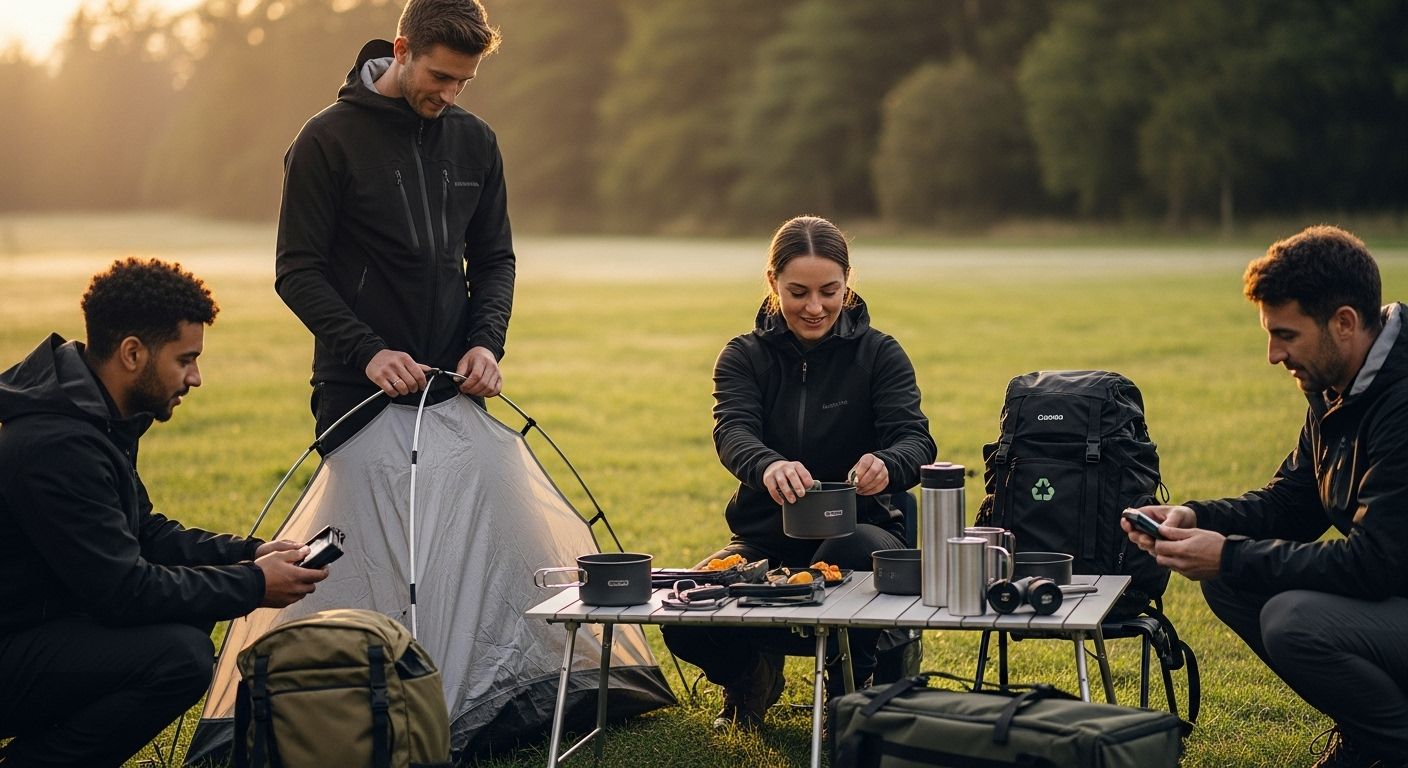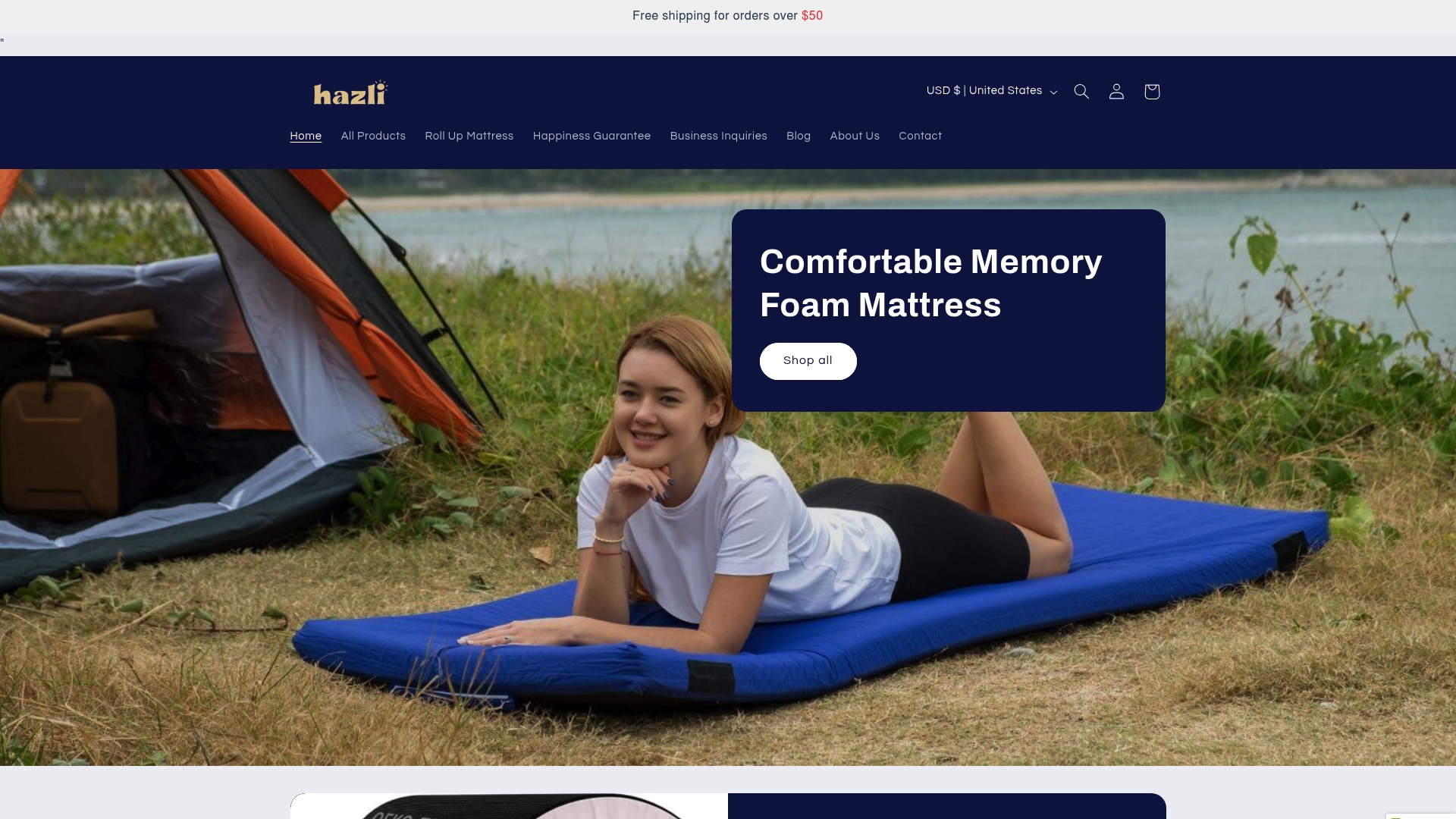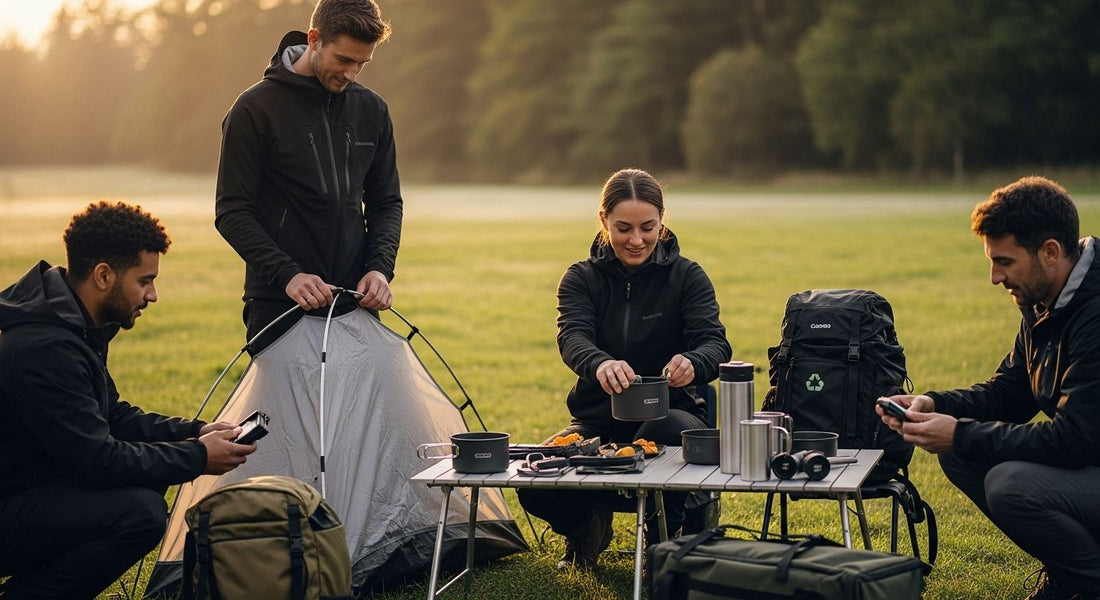
Camping gear has changed fast and what you pack can completely reshape your outdoor adventure. Think about this. Modern ultralight tents now weigh less than 2 pounds compared to the old 5 or 7-pound models. Most people imagine traveling lighter means sacrificing comfort or safety. Actually, the smartest campers in 2025 are getting more comfort, more protection, and more fun than ever because they know exactly what to look for and how to use the latest outdoor gear.
Table of Contents
- Choose Lightweight Gear For Easier Travel
- Invest In Multi-Use Equipment
- Stay Updated On Eco-Friendly Options
- Focus On Weather-Resistant Materials
- Prioritize Safety Gear For Peace Of Mind
- Organize Your Gear For Quick Access
- Learn To Test Gear Before Your Trip
Quick Summary
| Takeaway | Explanation |
|---|---|
| Choose lightweight gear for mobility. | Opt for ultralight materials to enhance comfort and ease of transport without sacrificing durability. |
| Invest in multi-use equipment. | Select versatile gear to reduce pack weight and increase functionality for varied outdoor situations. |
| Prioritize eco-friendly options. | Select gear made from recycled materials to minimize environmental impact during outdoor activities. |
| Focus on weather resistance. | Choose advanced materials that offer comprehensive protection against harsh environmental conditions. |
| Test gear before trips. | Verify functionality and practice equipment use to ensure a smooth and safe outdoor experience. |
1: Choose Lightweight Gear for Easier Travel
As camping technology advances, selecting lightweight gear has become a critical strategy for modern outdoor enthusiasts. The days of hauling heavy equipment through wilderness trails are transitioning toward smarter, more efficient packing methods that prioritize mobility and comfort.
When approaching camping gear selection in 2025, weight becomes a paramount consideration. Ultralight materials like carbon fiber, advanced synthetic fabrics, and aerospace grade aluminum are revolutionizing outdoor equipment design. These innovative materials significantly reduce pack weight without compromising durability or performance.
Key considerations for selecting lightweight camping gear include:
- Multifunction potential: Choose items serving multiple purposes
- Material weight: Prioritize gear under 2 pounds per item
- Compactness: Select equipment that collapses or packs efficiently
According to Outdoor Gear Lab, modern camping gear technologies have reduced traditional tent weights from 5-7 pounds to under 2 pounds, representing a significant advancement in portable outdoor equipment design.
Strategic gear selection means understanding the trade offs between weight, durability, and functionality. Experienced campers recognize that every ounce matters when traversing challenging terrains. Lightweight doesn’t mean sacrificing quality modern camping gear increasingly combines advanced engineering with intelligent design principles.
Prioritize gear that offers maximum utility with minimal weight. Consider modular equipment systems that allow customization based on specific trip requirements. This approach enables campers to create personalized gear configurations matching their unique adventure needs without unnecessary bulk.
2: Invest in Multi-Use Equipment
In 2025, smart campers recognize that versatility is the cornerstone of efficient outdoor gear selection. Multi-use equipment transforms traditional camping experiences by reducing pack weight, minimizing unnecessary items, and providing practical solutions for various outdoor scenarios.
The philosophy of multi-use gear goes beyond simple convenience. It represents a strategic approach to camping that prioritizes efficiency, adaptability, and resourcefulness. Modern camping technology has evolved to create innovative products that serve multiple functions without compromising individual performance.
Key strategies for selecting multi-use equipment include:
- Adaptable design: Choose gear with flexible configurations
- Compact functionality: Prioritize items serving multiple purposes
- Material durability: Select equipment that withstands diverse conditions
According to Scouting Magazine, versatile equipment can dramatically transform camping experiences. For instance, a single item like a sleeping bag can function as emergency shelter, ground cover, or additional clothing layer during unexpected temperature drops.
Practical examples of multi-use gear include convertible clothing with zip-off legs, cooking utensils that double as tools, and compact sleeping systems that integrate insulation and waterproofing. These innovative designs eliminate the need for carrying multiple specialized items, creating a more streamlined and efficient outdoor experience.
Investing in multi-use equipment requires careful consideration of individual camping styles, anticipated environmental conditions, and personal comfort requirements. Campers should evaluate each piece of gear not just for its primary function, but for its potential auxiliary uses and overall versatility in different outdoor scenarios.
3: Stay Updated on Eco-Friendly Options
The camping landscape of 2025 demands a heightened awareness of environmental sustainability. Eco-friendly camping gear represents more than a trend it is a critical approach to preserving natural environments while enjoying outdoor experiences.
Modern campers understand that environmental responsibility begins with conscious equipment choices. Manufacturers are now developing camping gear using recycled materials, renewable resources, and advanced sustainable production techniques that minimize ecological impact.
Key considerations for selecting eco-friendly camping equipment include:
- Material sourcing: Prioritize gear made from recycled or sustainable materials
- Manufacturing processes: Select brands committed to reducing carbon footprints
- Product lifecycle: Choose equipment designed for longevity and minimal waste
According to the U.S. Environmental Protection Agency, reducing waste through strategic product selection is fundamental to environmental conservation. This approach extends directly to camping gear selection, where informed choices can significantly decrease ecological impact.
Innovative materials are transforming camping equipment. Manufacturers now utilize materials like recycled plastics, bamboo fibers, organic cotton, and regenerated nylon to create high performance gear that reduces environmental strain. These advancements demonstrate that sustainability and performance can coexist effectively.
Staying updated requires active engagement. Follow outdoor gear publications, attend camping expos, participate in sustainability focused outdoor communities, and research brands committed to green innovation. Understanding emerging technologies and materials helps campers make informed decisions that align with environmental preservation goals.
The future of camping gear is intrinsically linked to ecological responsibility. By prioritizing eco-friendly options, campers contribute to protecting the wilderness they love while enjoying cutting edge equipment designed with both performance and planetary health in mind.
4: Focus on Weather-Resistant Materials
In 2025, camping gear demands sophisticated protection against unpredictable environmental conditions. Weather-resistant materials have become a critical factor in outdoor equipment selection, transforming how campers prepare for diverse climatic challenges.
Modern camping technology integrates advanced material science to create gear that withstands extreme temperatures, sudden precipitation, and harsh wind conditions. These innovative materials go beyond traditional waterproofing, offering comprehensive protection while maintaining breathability and lightweight performance.
Key considerations for selecting weather-resistant gear include:
- Performance ratings: Evaluate water resistance and temperature range
- Material composition: Prioritize technical fabrics with advanced protective properties
- Durability: Select materials that maintain performance after repeated exposure
According to Research Gate, recent technological developments have dramatically improved outdoor gear’s ability to protect against environmental extremes. Cutting edge textiles now integrate nanomaterials and molecular engineering to create superior weather protection.
Breakthrough materials like graphene-enhanced fabrics and ceramic-infused membranes represent the next generation of weather-resistant technology. These innovations provide superior protection by creating microscopic barriers that repel water, block wind, and regulate temperature more effectively than traditional materials.
Campers should look for gear featuring multi-layer construction, sealed seams, and advanced moisture-wicking properties. The goal is comprehensive protection that adapts to changing environmental conditions while maintaining comfort and mobility. Strategic material selection means understanding how different fabrics perform under various weather scenarios, from alpine conditions to humid forest environments.
5: Prioritize Safety Gear for Peace of Mind
Camping in 2025 demands a proactive approach to personal safety. Safety gear is no longer an optional luxury but a critical component of responsible outdoor exploration. Understanding and investing in comprehensive safety equipment can mean the difference between a minor inconvenience and a potential life-threatening situation.
Modern safety technology has revolutionized outdoor preparedness, offering compact, lightweight solutions that provide extensive protection without compromising mobility or comfort. Campers now have access to sophisticated tools that blend advanced engineering with practical design.
Key safety considerations for camping equipment include:
- Emergency communication: Carry reliable communication devices
- First aid capabilities: Pack comprehensive medical kits
- Protective personal equipment: Include weather and terrain appropriate safety gear
According to the National Safety Council, understanding potential risks and preparing accordingly dramatically reduces the likelihood of outdoor emergencies. Technological advancements have made safety equipment more accessible and user-friendly than ever before.
Critical safety technologies now integrate smart features like GPS tracking, emergency beacon functionality, and real-time health monitoring. Wearable devices can now detect environmental hazards, track vital signs, and automatically alert emergency services if unexpected situations arise.
Comprehensive safety preparation extends beyond individual equipment. Campers should develop situational awareness, understand their environment, and maintain clear communication plans with fellow travelers and emergency contacts. Each piece of safety gear represents an investment in personal security and peace of mind.
The most advanced safety gear combines multiple functions. Multipurpose tools, compact survival kits, and intelligent wearable technologies provide layers of protection that adapt to changing outdoor conditions. Smart campers recognize that safety is not about eliminating risk, but about managing potential challenges effectively.
6: Organize Your Gear for Quick Access
Effective gear organization transforms camping experiences from chaotic to seamless. Strategic packing is not just about fitting items into limited space it is about creating a systematic approach that ensures immediate access to critical equipment when needed most.
In 2025, camping gear organization has evolved beyond traditional storage methods. Advanced modular systems, smart compartmentalization, and intelligent design principles now allow campers to create highly efficient, easily navigable equipment configurations.
Key strategies for optimizing gear organization include:
- Color coding: Use distinct colors for different equipment categories
- Modular storage: Select bags and containers with flexible configurations
- Logical placement: Position frequently used items in most accessible locations
According to the U.S. Forest Service, efficient gear organization minimizes site disruption and improves overall camping experience. Thoughtful arrangement prevents unnecessary searching and reduces stress during outdoor adventures.
Technological innovations now support gear organization through smart storage solutions. Compression bags with integrated digital tracking, waterproof containers with compartment technology, and lightweight organizational systems make packing more intuitive and streamlined.
Campers should develop a consistent organizational system that remains uniform across different trips. This approach creates muscle memory and reduces cognitive load when setting up camp or responding to changing environmental conditions. Consider categorizing gear by function emergency equipment, cooking supplies, sleeping gear and prioritize accessibility based on potential usage scenarios.
Ultimately, gear organization is about creating a personalized system that matches individual camping styles and anticipated environmental challenges. The goal is developing a method that feels natural, reduces unnecessary movement, and allows immediate access to critical equipment when every moment counts.
7: Learn to Test Gear Before Your Trip
Preparing for a camping adventure requires more than simply purchasing equipment. Gear testing is a critical step that transforms potential equipment failures into predictable, manageable experiences. Understanding how your gear performs before entering wilderness environments can mean the difference between a successful trip and a potential emergency.
Modern camping technology offers sophisticated gear that demands careful pre-trip evaluation. Each piece of equipment requires specific knowledge about its functionality, limitations, and proper deployment techniques. Campers who invest time in comprehensive gear testing develop confidence and competence that directly translates to outdoor safety.
Key testing considerations include:
- Functionality checks: Verify each item works as intended
- Simulated conditions: Recreate potential outdoor scenarios
- Practice assembly: Learn equipment setup before actual trip
According to the USDA Forest Service, practicing with equipment at home helps campers identify potential issues and develop necessary skills before encountering challenging outdoor conditions. This proactive approach minimizes risks and enhances overall camping preparedness.
Comprehensive testing involves more than simply opening a tent or checking a flashlight. Campers should simulate actual usage conditions, test equipment functionality in environments similar to their planned destination, and become intimately familiar with each item’s operation.
Technology has made gear testing more accessible through detailed online tutorials, manufacturer instructional videos, and community forums where experienced campers share insights. Smartphone apps now offer interactive guides for equipment setup and maintenance, providing real-time support for gear preparation.
Effective gear testing is about building muscle memory, understanding equipment limitations, and developing a holistic approach to outdoor preparedness. By investing time in thorough equipment evaluation, campers transform potential challenges into manageable experiences, ensuring safer and more enjoyable wilderness adventures.
Below is a comprehensive table summarizing the seven essential camping gear tips for 2025, highlighting each main point, its key focus, and practical benefits for campers.
| Tip | Key Focus | Practical Benefit |
|---|---|---|
| Choose Lightweight Gear | Ultralight materials, weight under 2 lbs | Increases mobility and comfort without sacrificing durability |
| Invest in Multi-Use Equipment | Versatility, adaptable design | Reduces pack weight, offers multiple uses in varied scenarios |
| Stay Updated on Eco-Friendly Options | Sustainable/recycled materials, longevity | Minimizes environmental impact while maintaining high performance |
| Focus on Weather-Resistant Materials | Advanced textiles, comprehensive protection | Shields against extreme weather while staying light and breathable |
| Prioritize Safety Gear | Modern emergency technology, user-friendly | Enhances safety, quick response to outdoor emergencies |
| Organize Your Gear for Quick Access | Modular, color-coded, logical arrangement | Ensures critical gear is easy to find and use quickly |
| Learn to Test Gear Before Your Trip | Functionality checks, practice, simulation | Prevents failures, improves preparedness and confidence |
Transform Your Camping Experience With Hazli Collection
Do you ever struggle to find the right balance between lightweight comfort and all-night durability in your camping gear? As highlighted in “7 Essential Camping Gear Tips for 2025,” modern campers demand gear that is versatile, eco-friendly, and reliable while also delivering superior sleep in any setting. Many outdoor enthusiasts still face the challenge of bulky equipment or restless nights due to poor-quality sleeping solutions, undermining the joy of outdoor adventure.

Put an end to uncomfortable nights and unnecessary packing stress by exploring the trusted selection at Hazli Collection. Discover premium memory foam mattresses designed for quick setup, lightweight travel, and dependable support you can count on. Upgrade your camping essentials today and enjoy gear that meets all the latest performance, safety, and comfort standards. Experience worry-free adventures—visit Hazli Collection now and choose the outdoor sleep solutions that make every trip unforgettable.
Frequently Asked Questions
What materials should I look for when choosing lightweight camping gear?
When selecting lightweight camping gear, prioritize ultralight materials such as carbon fiber, advanced synthetic fabrics, and aerospace-grade aluminum. Aim for gear that weighs under 2 pounds per item for optimal portability.
How can I ensure my camping gear is multifunctional?
Choose equipment that has adaptable designs and can serve multiple purposes. Examples include convertible clothing, cooking utensils that double as tools, and sleeping systems that integrate insulation and waterproofing.
What are some eco-friendly materials to consider for camping gear?
Look for camping gear made from recycled plastics, bamboo fibers, organic cotton, and regenerated nylon. These materials not only perform well but also help reduce environmental impact during outdoor activities.
How can I organize my camping gear for quick access?
Utilize modular storage solutions and color-coded systems to categorize your gear. Place frequently used items in easily accessible locations and develop a consistent organization method that suits your camping style.

